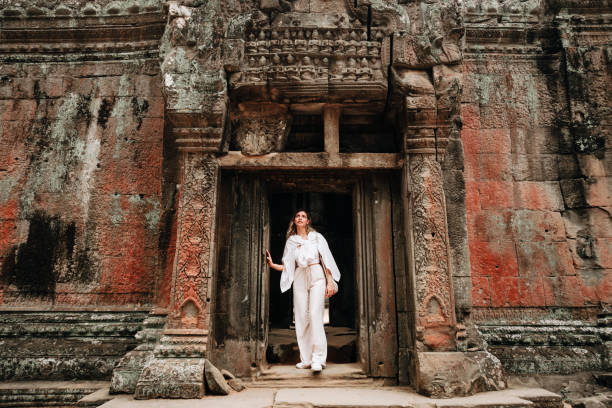Take a Trip with Us to the Historical Places - The Footstep Everywhere Tells a Story.
Travel does not only mean checking off the list of places or taking epic pictures. It is about relatedness it is about being connected to the past, to people, and to the mute murmurs of civilizations that have formed us the way we are today. Traditional landmarks all over the globe are the living storytellers, eternal witnesses of the human achievements, dreams, religion, and imagination.
You are not sightseeing when you peruse the ancient ramparts of a fort, or in front of a temple, or in the little lanes of an old town, you are walking with centuries of memory. The weight of the stories that should be heard is on each stone under your feet.
We shall go on this journey together, to the greatest historic places in all the world, and the steps that we take tell us a story, and the places that we see are a window into the past.
What Is It that Makes a Landmark Traditional?
A historic landmark is not just a historic monument. It is the pulse of a place - it is a warehouse of narratives, faith and a trade that has passed down through the ages. These destinations define the human culture.
It may be an ancient market that is still actively trading, a temple whose walls are flushed with religious carvings, or a fort that used to protect long-forgotten kingdoms. Each of the landmarks represents the soul of people, their religion, their craftsmanship, and their endurance.
It is like visiting a living museum when walking in such spaces. The sculpted roofs, old-fashioned walls and decayed gates narrate tales more vivid than any book. One statuette can be indicative of the faith of an era, and an erased signature can indicate a lost episode of the past. Even the cobbled streets appear to be trembling with the beat of lives that were lived here - merchants and musicians and children playing.
These monuments are not protecting simply beauty but linking us to our history and making us remember that we are all one continuous human narrative.
The reason to visit traditional landmarks?
When we visit historic sites it is not a question of the past but rather a question of rediscovering ourselves with the help of the past. These are the reasons why such places are so magical:
1. Cultural Immersion:
Best culture narrators are traditional landmarks. It is through rituals and music to food and festivals that they assist the travelers to view how people used to live, pray and celebrate. Reading them makes you enter into a different lifestyle not as a spectator, but as a player in a human drama.
2. A Journey Through History:
Every monument, citadel, or palace is a chapter hewn out of stone. They make us realize the evolution of the societies, the uprising and downfall of empires, and the way architecture became a symbol of human values and strength.
3. Architectural Brilliance:
It could be the intricate filigree of Mughal palaces, the engineering wonders of Roman amphitheaters or the calm symmetry of Japanese temples, the historic landmark buildings are a glorification of the imagination and ability of the human race. All the structures are eloquent in art and permanence.
4. A Chance for Reflection:
It is demeaning to be standing in the presence of ancient ruins. It brings back to mind the silent power of time. Succeeding generations constructed, thought, and dreamed - and they have a legacy. When we are in their company, we see how temporary life can be and how enduring creativity and soul can be.
Famous Destinations of the World.
1. India -A Journey through Living Heritage.
India depicts its history more than most nations. The Taj Mahal at Agra narrates a classic love tale hewn out of marble. The Red Fort of Delhi is re-echoing the names of emperors and revolutionists. The Amber Fort in Rajasthan is a golden crown on the Aravalli Hills, which talks of the Rajput heroism and magnificence. In the south, the remains of the Hampi allows a procession of the splendour of the Vijayanagara Empire, the land of art and spirituality.
These places, both sacred and royal, are living lessons, lessons of devotion, of endurance, and design, lessons that are timeless.
2. Europe - Where the Past Smarts in Each Brick.
Europe is a treasure chest of the human civilization. The Colosseum of Rome is filled with cheers of ancient gladiators and Roman appetites of spectacle. The Tower of London is full of royal intrigue, incarceration and authority that dates back centuries. The Versailles Palace outside Paris has dazzling halls that are a reflection of the grandeur and luxury of the French royalty.
All cobbled streets, all cathedral spires, all sleaked castles in Europe will prompt us to think of our common human need, our need to construct, to belong, to be remembered.
3. Middle East: Home of the Civilizations.
History in the Middle East comes directly out of the desert sands. The Pyramids of Giza remain enigmatic with their geometry and good greatness. The rose-colored town of Petra carved in the cliffs of Jordan tells about the skill of ancient Nabataean architects and their ability to construct the cities out of the stone. They are not only ruins, but they are witnesses to human genius which has lived thousands of years ago.
4. Asia Where Spirituality Meets Architecture.
The landmarks of Asia are the places where art and faith go hand in hand. Angkor Wat in Cambodia is a great place of worship and godly artistry. At Kyoto, Japan, the wooden structure of the shrines and Zen gardens merge with the surrounding trees and bring harmony between the work of human hands and the land. All the sites are not only beautiful, but also find tranquility, a place to stop and see.
5. The Narratives behind Each Step.
To walk into a storybook is to visit a historic site without words. It is like being in a court, an old courtyard, the one where the kings used to walk, the poets used to sing, and, long ago, crowds used to gather to celebrate. You have an echo of laughter, struggle and hope in every stone under your feet.
Even the minutest things a fading fresco, an inscription half-covered with dust, a carved pattern on the wall of a temple contain in themselves the remains of human experience. Their combination creates a picture of life as it used to be.
These mute details stir up imagination when we actually take time and look. We do not see ruins any more, we see tales, which have come to life through our consciousness.
The Hints in the Tour of traditional landmarks.
Research Before You Go: The history of a site will help you appreciate your visit. Get to know who constructed it and why as well as what it represents.
Hire a Local Guide: A good guide is one who takes facts and turns them into stories. They have covert myths and personal revelations that no book can provide.
Adore the Site: Most landmarks are religious or delicate. Wear simple clothes, obey local traditions, and touch no sensitive surfaces.
Take Your Time: Don't rush. Take breaks, relax and allow the place to talk to you.
Pay Attention to taking pictures: You capture the beauty, however, do not allow camera to take your place. There are moments that are the most significant that cannot be captured by photography but they have to be experienced.
6. The Affective Strength of Historic Places.
The sightseeing of traditional sites is very emotional. There is nothing like being in front of a temple or palace that is centuries old and feeling awe - the sense that you are not alone in this big and ancient thing.
You are humbled by the fact that you are in streets that have housed many lives than yours. You are thankful to the innovativeness and perseverance of the predecessors. These are the grounds that unite generations and make us remember that humanity, despite the diversity, has a common heartbeat.
In a world that tends to be overly fast, historic sites make us learn to take our time, to listen, to feel, and to remember.
Frequently Asked Questions
1. So, what are conventional landmarks?
They are historical or cultural sites that signify architecture, values and heritage of a region or a civilization.
2. Why should I visit them?
They provide history, art, culture and emotional attachment, all in a single experience.
3. What should I do in order to prepare such a visit?
Carry out a bit of research, get informed of the cultural situation and hopefully, go with a skilled local guide.
4. Are there any rules to follow?
Yes. Before littering the local customs, never destroy or deface heritage buildings.
5. What shall I seek as I look about?
Look at the carvings, inscriptions, paintings, layouts--they give the history of the stones.
6. Are these locations emotive?
Absolutely. They create a sense of amazement, modesty and an intense belonging to the overall narrative of humanity.
7. Can children visit?
Yes! It is an excellent method of bringing them to culture and history simply learn to respect the place.
8. Are they solely the destinations of history lovers?
Not at all. Artists, photographers, spiritualists, and even the ordinary tourists will be inspired here.
9. What determines my decision on what landmarks to visit?
Make it according to your own interests, whether it is architecture, spirituality, or royal history, and study availability and security.
10. Are guided tours worth it?
Definitely. They show us strata of history and personal stories of which you might be otherwise ignorant.
Closure: Walking Through Time.
Traditional landmarks are not about a box that can be ticked and finished after visiting well known locations but rather about time itself. Each temple, fort, palace, or street has got a heartbeat a reminder that man and spirit will live long after ages.
These sites teach us to respect - culture, artisanship, and the delicacy of the past. They are reminding us that we are not our own independent of the past; that we are its continuation.
Come with us then, come, travel with us, through time-worn streets and holy halls, through the shouts of prayer and mirth. Hear the tales that the stones relate. You can feel the centuries under your feet.
Since you are not merely a tourist when you stroll through the historic places with a sense of realization and a heart, you are not a tourist.
You have become a character of the narrative.






